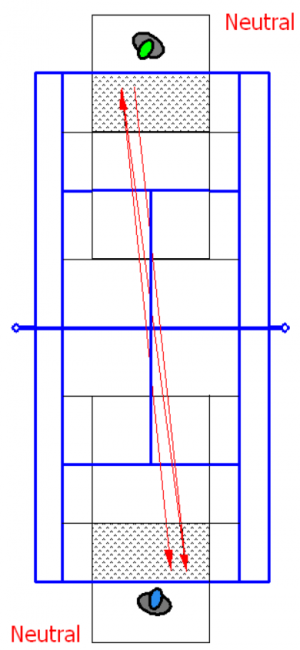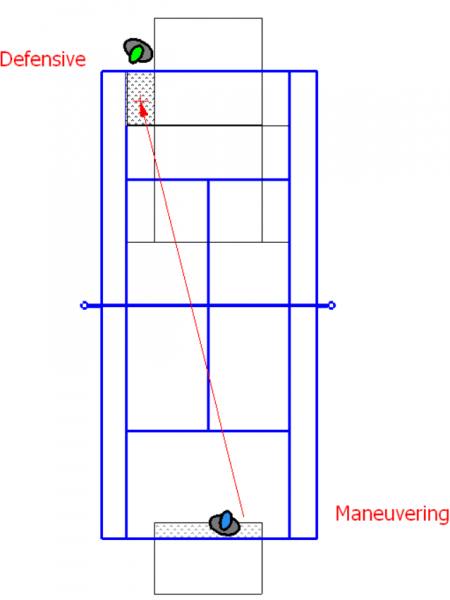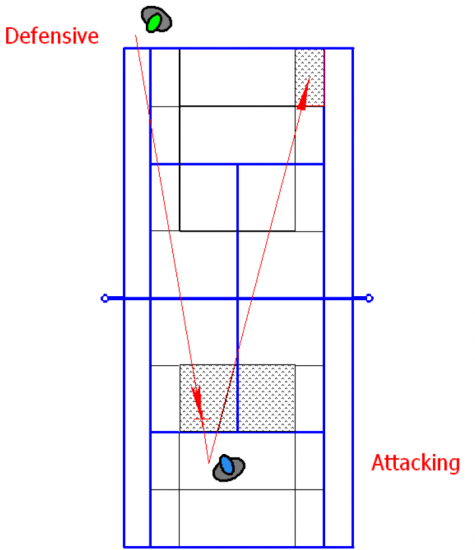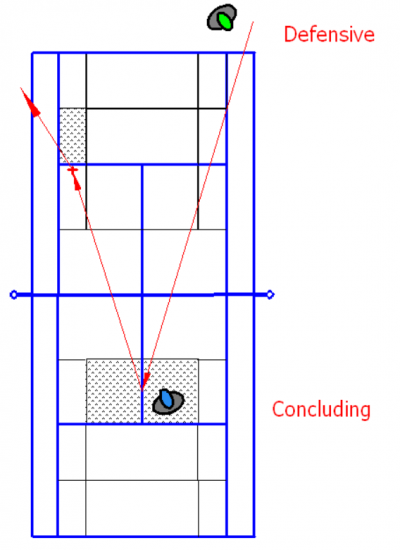So far, in recent editions of The Point, our discussion has been about where the ball goes when you hit it. The 7 Shot™ notation system is simple, and I hope easy to remember. Now we’ll open the discussion about your side of the net: what’s your position and, importantly, what’s your tactical situation when you are hitting the ball.
There are five basic tactical situations that arise during tennis play, namely DNMAC, which stand for the tactical situations defense, neutral, maneuver, attack and conclude. Maneuver, attack and conclude are offensive tactics.
Neutral
Imagine an area behind each baseline that is the same size as “the 3.” If players are in these two areas trading shots with each other (see Fig. 1), we can think of each of those areas as a “neutral box”. Typically, we can say both players are in a “neutral tactical position” because neither player at this stage of a point has an advantage over the other player.
.

Maneuver
If one of the players (let’s call her “Sally”, the blue player in the figures) were able to adjust her court position by moving to just inside the baseline with both feet, and play a shot to “the 4”, the impact of that shot would be to move, or maneuver, her opponent (let’s call her “Jane”, the green player in the figures) away from the center box behind the baseline. Players starting at UTR Level 4 should be encouraged to try making this shot. Typically, we can say that now Sally (blue player) is in a “maneuvering” tactical position and that Jane (green player) has moved from a neutral to a defensive situation, as the players are no longer on an equal footing. See Fig. 2.

Attack
In the above illustration, Sally, a UTR Level 6, hit a forehand to the 4 from a maneuvering position. Let’s suppose that her opponent, Jane, also a UTR Level 6, was able to return Sally’s shot, albeit short into Sally’s end of the court with the ball landing in “the 1”.
Now, let’s also suppose that Sally has time to get to this short ball and to be in position to hit her next shot to “the 4” on the ad side of Jane’s court, and to attack by closing in toward the net (Fig. 3). Typically, we can say that now Sally (blue player) is in an “attacking” tactical position.

Conclude
Let’s say Sally used her backhand to attack (Fig. 3).
Now, as Sally moves closer to the net, Jane moves quickly across her baseline and plays one more return, a backhand shot to “the 1”. (Fig. 4)
By this time Sally (blue player) has taken up a position about a racket’s length inside the service line a little to the right of center, still inside her center corridor. From there Sally closes in to finish the point with a winning backhand volley to “the 5” from a “concluding” tactical position well inside her service line, as illustrated in Fig. 4.
Typically, we can say that for Sally’s final shot (Fig. 4), she was in a “concluding” tactical situation, as she was in a position near or approaching the net where she was intending either to win the point outright with her shot or at least put her opponent into a very weak defensive position.

The above illustrations are typical examples of neutral, maneuvering, attacking and concluding situations and court positions. In future articles we’ll discuss each tactical situation individually.
In the above discussion, Sally (blue player) has been the player who has moved from neutral to offense. Jane (green player) has gone from neutral to defense. In Jane’s behalf, you can applaud her in that she made Sally win the point over the course of three shots by keeping the ball in play for two successive defensive shots. Of course, you can also applaud Sally, who successfully constructed a four-shot (NMAC) combination to win the point.
In the book, “Standard TENNIS MATCH CHARTING and NOTATION” (available online here) we guide you through identifying and organizing how to annotate points by recording, for each point, the effect, stroke, target, tactical areas and counts and combinations, which will enable you to collect the most meaningful information from matches. The information you collect will help players and coaches work together to lay out a plan for match performance improvement. I would also highly recommend this book for any parent who takes time to watch kids play matches. Tennis is a difficult game. Not knowing what goes on out there on the court leads to a great deal of misunderstanding between players, coaches and parents.
NEXT POINT
The focus in the next article will be a deeper look at typical Defensive challenges all players face at every stage of their playing life. As a preview we will discuss the “blind spot”, which all players deal with when the ball gets too close to them; those short low shots that you are required to “dig out” as you run forward to reach the ball; “plane-breakers”, in which you have to play shots that are wide of your normal reach; and lastly, high balls, which are tough to find any leverage to defend.

